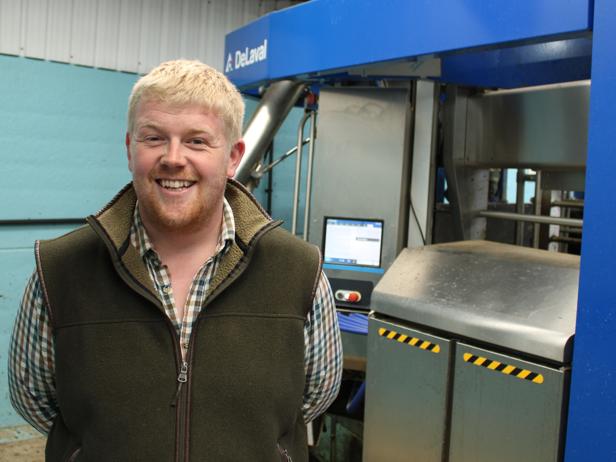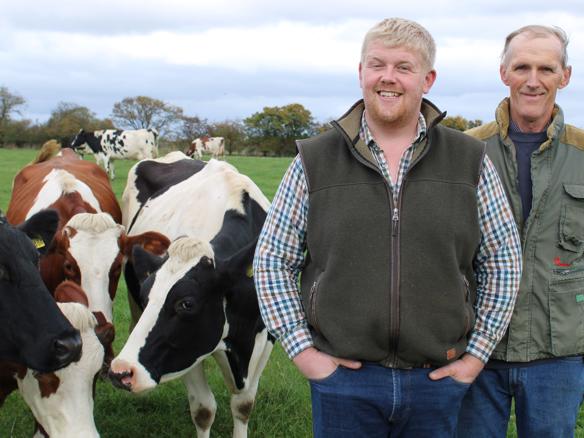Home
Learn
Customer testimonials
Ross Johnson
Ross Johnson

Ross Johnson - North Yorkshire
Farm location
North Yorkshire
Herd size
155
“We have achieved all of our goals. The cows are out as much as possible, milk yields are rising, cow health has improved and we have not had to employ any additional labour."
5th generation dairy farmer, Ross Johnson, is using milking robots with a grazing system. Since installing the robots in February 2021 he has seen milk yield rise by 300 litres per cow and is expecting to reach 8000 litres per annum in 2023.
Farming with his father, Colin, and uncle Robin, Mr Johnson chose to retain a grazing system and install the robots to give the family more time to focus on milk from forage and improving grass quality. Working with DeLaval he was advised that an A, B, C grazing system could be established and the robots installed without the need for any new buildings.
“To keep the cows out as much of the year, and minimise the infrastructure costs, was a significant advantage that enabled us to keep costs down and prioritise cow welfare. We didn’t want to milk in a conventional parlour but we also didn’t want to bring all the cows in all year round, so DeLaval’s grazing system and VMS V310 robots were the best fit,” he explains.
The 155 milkers are split between three robots over two sheds. One shed houses two robots for the lower yielding cows and a smaller shed has a single robot for cows that freshly calved or up to 150 days in milk. The smaller shed houses the cows for longer periods but there is still access to grazing for three hours a day. Both sheds were adapted to house the robots with only one extension needed to the larger building. The collecting yard was located in front of the smaller shed and this was used to house the single robot which made best use of the space available

“We are year round calving so there is a constant flow of high yielding cows from one shed to the other. We want all the cows to feel the sun on their backs, get fresh air and a break from the concrete. As their yield reduces, we move them to the larger shed where they have full access to graze throughout the day. Keeping existing buildings has saved a significant amount of money and the cows never needed to be rehoused,” he says.
The clever three-way gate links the shed to a series of cow tracks and the cows never have to walk more than 650 metres. This enables the farm to be split into areas for rotational grazing and outlying fields to be used for silage production. The sheds are surrounded on all sides by pasture which is a significant benefit for the farm and made implementing the system far easier.
“The three-way gate gives permission to cows to both leave and enter the robots. The cows are driven by food so only come in to be milked and spend the remaining time at pasture. “The gate will only allow a cow access to pasture if she has been milked and she can only come back in when she is ready to be milked. It took some weeks to adjust the herd to the system, but it has been working very well since,” he says.
Cow health has improved with SCC’s dropping from 150 to 120 and mastitis cases to just one every 10 weeks. The family praise the teat preparation and robot milking for this, citing the robot’s ability to learn and log the position of each cow’s teats. The robots have also helped to improve foot health through the installation of a footbath which is largely chemical free and has reduced cases of dermatitis.
“We have also noticed a change in cow behaviour. The herd is calmer and more biddable. We carry out our own AI and the cows are much easier to move into the crush and work with. Mastitis Detection index (MDi) data from the robots has also helped us to monitor conductivity and blood count to catch issues sooner,” he adds.
“It is a different way of farming that relies far more on technology. However, we have all welcomed this because it is giving us more time to focus on cow health, productivity and welfare. Using Delpro we can monitor individual milk yield and establish what is causing it to fluctuate. Because we are no longer tied to the parlour we can use this time to address any concerns and improve our system,” he says.
“We have more time to focus on grazing and silage production. We have never been a high yielding herd, but the robots are making a significant difference and we are well on our way to exceeding 8000 litres per cow per year. We have started to use different grass varieties such as intermediate perennials, there is clover in some but not all because we also have to control weeds,” he says.
The installation was handled entirely by DeLaval managing the layout and design of the grazing system and the implementation of the three-way gate. New cow tracks were added to improve cow flow and foot health. The combination of robot milking and improved grazing along with more time to improve grass and silage quality has come together without the need for any additional labour.
“We have achieved all of our goals. The cows are out as much as possible, milk yields are rising, cow health has improved and we have not had to employ any additional labour. We believe the robots essentially pay for themselves by enabling us to operate in this way. The move has secured the future of the farm and we also have the potential to grow by adding more robots and extending our sheds in the future,” he concludes.